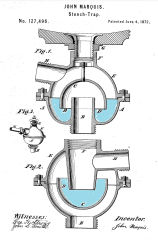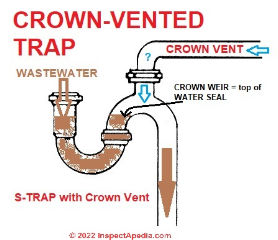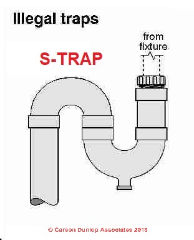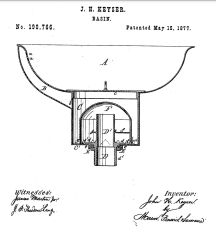 Prohibited Plumbing Traps
Prohibited Plumbing Traps
Obsolete or illegal plumbing trap types:
Bell trap, Crown-vented trap, Drum trap, Moving parts trap, Non-integral trap, S trap
- POST a QUESTION or COMMENT about plumbing traps or plumbing interceptors that are not to be used on modern residential structures.
Prohibited or "illegal" code violating plumbing drain traps, their types, history, features, and prohibitions.
The page top illustration, courtesy of Carson Dunlop Associates, shows four common plumbing drain traps no longer permitted by modern plumbing codes. Carson Dunlop is a Toronto home inspection, report writing tool, and education company.
This article lists types of plumbing traps prone to siphonage that can result in smelly and even dangerous sewer gas escaping from dry plumbing traps.
InspectAPedia tolerates no conflicts of interest. We have no relationship with advertisers, products, or services discussed at this website.
- Daniel Friedman, Publisher/Editor/Author - See WHO ARE WE?
Plumbing Traps that are Prohibited
Illustrated at the top of this page is a sketch by Carson Dunlop Associates , a Toronto home inspection and education firm, of several plumbing trap designs that are prohibited by modern plumbing codes, such as Chapter 10 of the IPC.Here's an excerpt:
UPC 1002.3 Prohibited types of plumbing traps.
The following types of traps are prohibited:
1. Traps that depend on moving parts to maintain the seal.
Above: Johnson's automatic sewer gas valve (1884), see also Brandeis 1877, both cited below.
By the late 1800's, it was observed that these more complex plumbing traps were prone to clogging and were more difficult to clean.
2. Bell traps. [Illustrated below]
See details at BELL TRAP HISTORY
3. Crown-vented traps. [Illustrated below]
A crown-vented plumbing trap is an S-trap to which is added an air vent connected at or near the uppermost crown of the S.
This illustration also shows the location of the crown weir, defined as the highest point on the inside bottom of the plumbing trap, also equaling the top of the water seal formed by the trap.
4. Traps not integral with a fixture and that depend on interior partitions for the seal, except those traps constructed of an approved material that is resistant to corrosion and degradation.
An example may be illustrated above at this patent disclosure of a plumbing trap remote from the plumbing fixture it serves and installed in a floor.
[Citation below among the plumbing trap patent disclosures]
5. “S” traps. [Illustrated below]
S-traps are often installed in older buildings where there is no venting provided for that plumbing fixture.
Details are at PLUMBING S-TRAP CODES & HAZARDS
6. Drum traps. [Illustrated below]
Shown above is an example of a drum trap installed below a bathroom lavatory sink in Central Mexico. Drum traps, with the exception given below, are prohibited in most plumbing jurisdictions.
Exception: Drum traps used as solids interceptors and drum traps serving chemical waste systems shall not be prohibited.
See details at DRUM TRAP HISTORY
See also IPC CHAPTER 10 TRAPS, INTERCEPTORS AND SEPARATORS [PDF]
Early Plumbing Traps
- 1775: Plumbing S-Trap - Alexander Cumming, credited with invention of the "S" trap used first on toilets, Alexander Cummings (b 1733 – d 8 March 1814)
- Keyser, J.H., BASIN [Wash Basin Combined with Trap] [PDF] U.S. Patent No. 190,766 Issued May 15, 1877 [Example of Bell Trap]
Note: this interesting sink trap design uses a bell trap built right into the bottom of a sink basin.
Excerpt:
The nature of my invention consists, first, in a wash-basin constructed with an extension below its bottom proper, for the purpose of forming a bell-trap chamber, said basin and chamber being in communication with one another by means of a removable section of the bottom of the basin, which section, when removed, admits of access to the chamber, and the removal of the bell-cover up through the basin, and thus the trap-chamber can be cleaned out without the necessity of disconnecting any other parts.
It consists, second, in the combination, with the basin, of a bell-trap chamber by means of an overflow-pipe, which discharges first into the bell-trap chamber, as will be presently described. It consists, third, in a coupling - collar formed on the waste-pipe of the bell-trap, in combination with the bell-cover, trap-chamber, and the basin, all as will be hereinafter described.
- Brandeis, Ludwig, BACK-WATER TRAP [PDF] U.S. Patent No. 197,511 Issued Nov. 27, 1877 [ Example of a plumbing trap with moving parts]
Note: this invention uses a check valve or flapper in a horizontal valve to avoid sewer backups; it’s not an actual trap.
See this patent at https://inspectapedia.com/plumbing/Brandeis-Patent-US197511.pdf
- Keith, D.S., WATER CLOSET [PDF] U.S. Patent No. 258,433 Issued May 23, 1882 [Example of a Bell Trap]
Excerpt:
Another part of my apparatus consists in a safe embracing a cistern bell-trap overflow and ventilator, in combination with a basin and a connecting-tube for the passage of water from basin to safe, said safe basin and tube being made in one piece, but in separate compartments, so as to effect a saving of water and keep the soil out of the compartments in which is the valve apparatus.
The connecting-tube feeds the cistern with water in such manner as to prevent any soil going with the water from the basin into the cistern and clogging the ball or valve, thus preventing the emitting of noxious odors or gases. Into this safe is also brought the horn or inlet of the basin, so that the valve can be connected therewith without piping, and requiring no putty joints, but merely a rubber washer, thus keeping all water-connections inside the safe.
See this patent at https://inspectapedia.com/plumbing/Keith-WC-Patent-US258433.pdf
- Johnson Frank G., AUTOMATIC SEWER GAS VALVE [PDF] U.S. Patent No. 306,929 Issued Oct. 21, 1884 [Illustrated below]
Note: Illustrates the complexity of some efforts to prevent passage of smelly, dangerous sewer gases out of the fixture drain and into the building.
See this patent at https://inspectapedia.com/plumbing/Johnson-Sewer-Gas-Valve-Patent-US306929.pdf
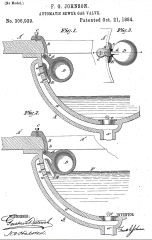
- Whipple, George C., (Chair), USDoC, RECOMMENDED MINIMUM REQUIREMENTS for PLUMBING, Report of Subcommittee on Plumbing of the Building Code Committee, [PDF] (1929) U.S. Department of Commerce, Bureau of Standards, August 30, 1928
Excerpts:
Sec. 6. Trap. — A trap is a fitting or device so constructed as toprevent the passage of air or gas through a pipe without materiallyaffecting the flow of sewage or waste water through it.
Sec. 7. Trap Seal — The trap seal is the vertical distance between the crown weir and the dip of the trap.
Sec. 8. Vent Pipe — A vent pipe is any pipe provided to ventilatea house-drainage system and to prevent trap siphonage and backpressure.
RESEALING OR ANTISIPHON TRAPS
The committee has given attention to the subject of antisiphon, nonsiphon, or resealing traps, as they are called. Practically all traps, except the plain traps already mentioned, may be included in this class.
There are many different kinds, many of them patented and more expensive than plain traps. They are supposed to resist siphonage better than plain traps by reason of having a deep seal, a greater area or volume, tortuous passages for the water, projecting lips, partitions, or, in some cases, moving parts. The best of the resealing traps when clean resist siphonage more than a plain trap of 2 to 4 inch seal, and this may be the case even when slightly fouled.
When more completely fouled, this resistance to siphonage rapidly lessens.
Properly designed resealing traps unvented and clean resist back pressure somewhat more than unvented plain traps of the same depth of seal, but the difference is not sufficient to justify their general use without vents. Their greater complexity causes them to clog more quickly than plain traps, and, if clogged, they are less easily cleaned by the householder and can not be thoroughly cleaned by the usual method of using a force pump or plunger.
Lack of standardization of these traps makes replacement more troublesome and expensive. The supposed advantages of a resealing trap lie in the fact that greater resistance to siphonage makes it possible to omit some of the vent pipes commonly installed and to use longer horizontal unvented waste-pipes and thus secure greater freedom in the location of fixtures. Long unvented horizontal runs, however, are in themselves objectionable.
...
Continue reading at PLUMBING TRAP LEAKS & MISSING INTERCEPTORS or select a topic from the closely-related articles below, or see the complete ARTICLE INDEX.
Or see PLUMBING TRAP, INTERCEPTOR FAQs - questions, answers, comments about plumbing traps
Or see these
Recommended Articles
Suggested citation for this web page
PLUMBING TRAPS, ILLEGAL at InspectApedia.com - online encyclopedia of building & environmental inspection, testing, diagnosis, repair, & problem prevention advice.
Or see this
INDEX to RELATED ARTICLES: ARTICLE INDEX to PLUMBING SYSTEMS
Or use the SEARCH BOX found below to Ask a Question or Search InspectApedia
Ask a Question or Search InspectApedia
Try the search box just below, or if you prefer, post a question or comment in the Comments box below and we will respond promptly.
Search the InspectApedia website
Note: appearance of your Comment below may be delayed: if your comment contains an image, photograph, web link, or text that looks to the software as if it might be a web link, your posting will appear after it has been approved by a moderator. Apologies for the delay.
Only one image can be added per comment but you can post as many comments, and therefore images, as you like.
You will not receive a notification when a response to your question has been posted.
Please bookmark this page to make it easy for you to check back for our response.
IF above you see "Comment Form is loading comments..." then COMMENT BOX - countable.ca / bawkbox.com IS NOT WORKING.
In any case you are welcome to send an email directly to us at InspectApedia.com at editor@inspectApedia.com
We'll reply to you directly. Please help us help you by noting, in your email, the URL of the InspectApedia page where you wanted to comment.
Citations & References
In addition to any citations in the article above, a full list is available on request.
- In addition to citations & references found in this article, see the research citations given at the end of the related articles found at our suggested
CONTINUE READING or RECOMMENDED ARTICLES.
- Carson, Dunlop & Associates Ltd., 120 Carlton Street Suite 407, Toronto ON M5A 4K2. Tel: (416) 964-9415 1-800-268-7070 Email: info@carsondunlop.com. Alan Carson is a past president of ASHI, the American Society of Home Inspectors.
Thanks to Alan Carson and Bob Dunlop, for permission for InspectAPedia to use text excerpts from The HOME REFERENCE BOOK - the Encyclopedia of Homes and to use illustrations from The ILLUSTRATED HOME .
Carson Dunlop Associates provides extensive home inspection education and report writing material. In gratitude we provide links to tsome Carson Dunlop Associates products and services.


